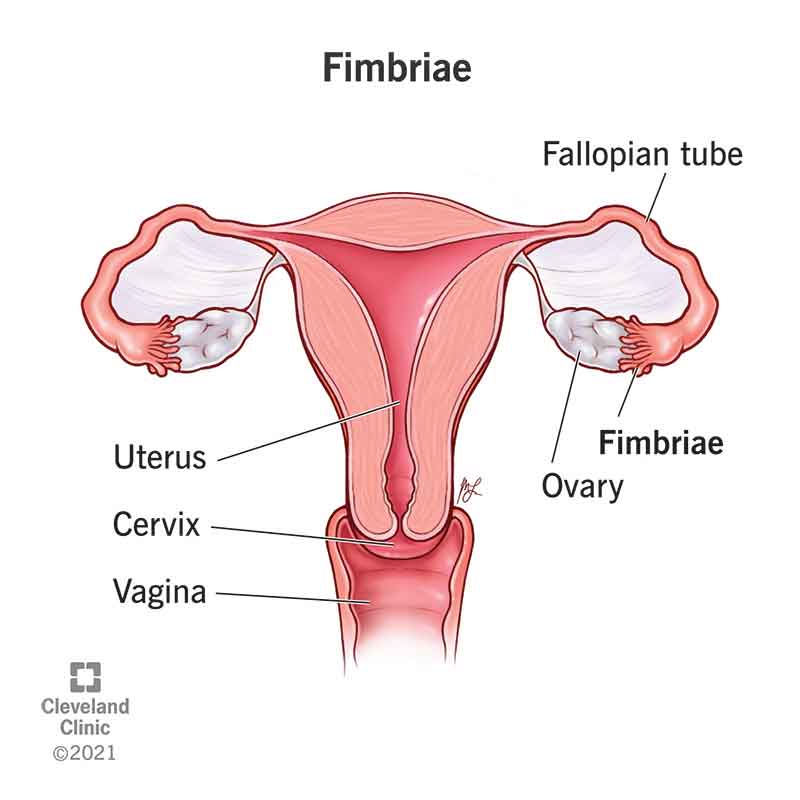Your fimbriae are finger-like projections at the ends of each of your fallopian tubes. Each month, they sweep a newly released egg from your ovaries into your fallopian tubes. Damaged fimbriae can negatively impact your fertility. Taking steps to prevent STIs can help keep your fimbriae and your fallopian tubes working correctly.
Advertisement
Cleveland Clinic is a non-profit academic medical center. Advertising on our site helps support our mission. We do not endorse non-Cleveland Clinic products or services. Policy

Fimbriae are finger-like projections on the ends of your fallopian tubes closest to your ovaries. Each month, your fimbriae catch the egg that one of your ovaries releases during ovulation. Your fimbriae then sweep the egg (ovum) into the fallopian tube where the egg can be fertilized. Your fimbriae are just one small portion of your fallopian tubes, but they play a significant role in conception.
Advertisement
Cleveland Clinic is a non-profit academic medical center. Advertising on our site helps support our mission. We do not endorse non-Cleveland Clinic products or services. Policy
Your fimbriae allow your ovaries and your fallopian tubes to work in sync. Your ovaries produce an egg, and your fimbriae usher that egg into your fallopian tubes at the exact right moment. Once inside your fallopian tubes, an egg can become fertilized if you have intercourse and a sperm reaches it.
Think of your fimbriae’s job as it relates to your fallopian tubes. Your fimbriae catch an egg so that your fallopian tubes can transport it.
If you have a normally functioning reproductive system, each month — as part of your menstrual cycle — one of your ovaries releases an egg. In response, your fimbriae extend over your ovary and catch the egg. Tiny hair-like structures that line the fimbriae called cilia beat rapidly in the direction of your uterus. This beating motion sweeps the egg into your fallopian tubes, where it can be fertilized by your partner’s or a donor’s sperm.
If the egg gets fertilized, it becomes an embryo. Your fallopian tubes transport the embryo to your uterus, where it implants into your uterine lining and can grow into a fetus. Your fallopian tubes also transport an unfertilized egg to your uterus. You eventually shed the egg, along with your uterine lining, during your period.
Advertisement
Conception and pregnancy depend on your fimbriae’s ability to extend and move freely to catch an egg.
You have two fallopian tubes, one tube on the left side and one tube on the right side of your body. Each fallopian tube extends from your uterus and ends with the fimbriae, near your ovaries. Your fallopian tubes have four parts:
Your fimbriae are the outermost part of your infundibulum. They extend near your ovaries.
When you’re not ovulating (ready to release an egg), the fimbriae are farther away from your ovary than when you’re ovulating. When you’re ready to release an egg, the fimbriae move in closer so that they can easily catch the egg and gently sweep it into your fallopian tube.
Your fallopian tubes consist of a lining that’s mostly columnar cells, cilia and multiple layers of muscle. These layers vary depending on the portion of the tube (intramural, isthmus, ampulla and infundibulum).
The fimbriae and the infundibulum are unique in that they have more cilia than the other parts of your fallopian tube.
Damaged fimbriae can cause infertility. Without the ability to move freely, your fimbriae can’t nudge an egg into your fallopian tube. If these finger-like extensions can’t open, your fallopian tubes can become blocked, preventing an egg from journeying through your fallopian tubes or being fertilized by sperm.
Conditions associated with infertility include:
The fimbriae are associated with some ovarian cancers. Research suggests that most ovarian high-grade serous carcinomas (HGSC) originate in the fallopian tubes, not the ovaries. They most likely originate in the fimbriae.
The tests commonly used to check your fallopian tubes also reveal information about your fimbriae. The tests can show whether your tubes are blocked:
Advertisement
As part of a salpingostomy (neosalpingostomy), your healthcare provider may also perform a fimbrioplasty. A salpingostomy drains excess fluid from your fallopian tubes and repairs any damage. Fimbrioplasty repairs your fimbriae in particular, rebuilding them so that they can move freely. These procedures are rare, and not everyone is a candidate for them.
The best way to keep your fimbriae healthy is to protect them from bacteria that could cause long-term damage. These bacteria are usually sexually transmitted. Taking steps to prevent STIs like chlamydia and gonorrhea through safer sex practices can go a long way when it comes to keeping your fimbriae (and your reproductive system) in good shape.
It’s important to have periodic testing for STIs and get treated if you receive a diagnosis. The longer you’re infected, the greater the likelihood that your fallopian tubes may be damaged.
Your fimbriae play a major role in your fertility. Blocked fallopian tubes can make it hard to conceive, and sealed fimbriae usually contribute to blockages. Keep your fimbriae healthy by reducing your risk of infection. If your fimbriae are damaged, speak to your healthcare provider about your best options for becoming pregnant.
Advertisement
From routine pelvic exams to high-risk pregnancies, Cleveland Clinic’s Ob/Gyns are here for you at any point in life.

Last reviewed on 10/25/2022.
Learn more about the Health Library and our editorial process.